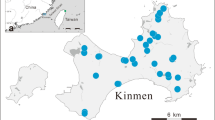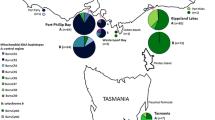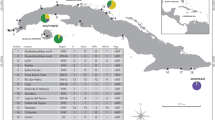Abstract
We assessed levels of genetic diversity and investigated patterns of population structure in three remnant populations of the endangered giant otter, Pteronura brasiliensis, using microsatellite loci. All populations displayed moderate to low levels of heterozygosity and allelic richness (H O 0.56–0.57, A R 4.00–5.15) and effective population sizes were low (N E 10.8–54) although only the Iténez population exhibited the signature of a genetic bottleneck. Population structure analyses revealed a pattern in which the populations of the Upper Amazon, Orinoco and Essequibo drainages comprised partially differentiated segments of a northern South American metapopulation, whereas the population of the Iténez appeared isolated. The observed patterns are congruent with previous mitochondrial DNA analysis which suggested the Iténez and northern South American groups constitute two evolutionary significant units. The results presented here should be considered in planning future policies aiming to manage the recovery of the giant otter across its range.



Similar content being viewed by others
References
Allendorf FW, Ryman N (2002) The role of genetics in population viability analysis. In: Beissinger SR, McCullough DR (eds) Population viability analysis. University of Chicago Press, Chicago, pp 50–85
Anderson S (1997) Mammals of Bolivia: taxonomy and distribution. Bull Am Mus Nat Hist 231:1–652
Armbruster JW (2003) Peckoltia sabaji, a new species from the Guyana Shield (Siluriformes: Loricariidae). Zootaxa 344:1–12
Banguera-Hinestroza E, Cárdenas H, Ruiz-Garcia M, Marmontel M, Gaitá E, Vázquez R, García-Vallejo F (2002) Molecular identification of evolutionarily significant units in the Amazon River Dolphin Inia sp. (Cetacea: Iniidae). Heredity 93:312–322
Beheler AS, Fike JA, Murfitt LM, Rhodes OE, Serfass TS (2004) Development of polymorphic microsatellite loci for North American river otters (Lontra canadensis) and amplification in related Mustelids. Mol Ecol Notes 4:56–58
Beheler AS, Fike JA, Dharmarajan G, Rhodes OE, Serfass TS (2005) Ten new polymorphic microsatellite loci for North American river otters (Lontra canadensis) and their utility in related mustelids. Mol Ecol Notes 5:602–604
Carter SK, Rosas FCW (1997) Biology and conservation of the giant otter Pteronura brasiliensis. Mamm Rev 27:1–26
Channell R, Lomolino MV (2000) Dynamic biogeography and conservation of endangered species. Nature 403:84–86
Chapell DE, van den Bussche RA, Krizan J, Patterson B (2004) Contrasting levels of genetic differentiation among populations of wolverines (Gulo gulo) from northern Canada revealed by nuclear and mitochondrial loci. Conserv Genet 5:759–767
Charlesworth B, Charlesworth D (1999) The genetic basis of inbreeding depression. Genet Res 74:329–340
Clement M, Posada D, Crandall KA (2000) TCS: a computer program to estimate gene genealogies. Mol Ecol 9:1657–1660
Cornuet JM, Luikart G (1997) Description and power analysis of two tests for detecting recent population bottlenecks from allele frequency data. Genetics 144:2001–2014
Crandall KA, Bininda-Emonds ORP, Mace GM, Wayne RK (2000) Considering evolutionary processes in conservation. Trends Ecol Evol 15:290–295
Crawford NG (2009) SMOGD: software for the measurement of genetic diversity. Mol Ecol Resour 10:556–557. doi:10.1111/j.1755-0998.2009.02801.x
Dallas JF, Piertney SB (1998) Microsatellite primers for the Eurasian otter. Mol Ecol 7:1247–1263
Duarte JCS, Rebelo GH (1985) Carnivore skins held in Brazil. Traffic Bull 7:1617
Duplaix N, Waldemarin HF, Groenedijk J, Evangelista E, Munis M, Valesco M, Botello JC (2008) Pteronura brasiliensis. In: IUCN 2010. IUCN red list of threatened species. Version 2010.4. www.iucnredlist.org. Downloaded on 12 May 2011
Evanno G, Regnaut S, Goudet J (2005) Detecting the number of clusters of individuals using the software STRUCTURE: a simulation study. Mol Ecol 14:2611–2620
Garner A, Rachlow JL, Hicks JF (2005) Patterns of genetic diversity and its loss in mammalian populations. Conserv Biol 19:1215–1221
Garza JC, Williamson EG (2001) Detection of reduction in population size using data from microsatellite loci. Mol Ecol 10:305–318
Gaston KJ (1990) Patterns in the geographical ranges of species. Biol Rev 65:105–129
Gilpin ME, Soulé ME (1986) Minimum viable populations: the processes of species extinctions. In: Soulé M (ed) Conservation biology: the science of scarcity and diversity. Sinauer Associates, Sunderland, pp 13–34
Gottgens JF, Perry JE, Fortney RH, Meyer JE, Benedict M, Rood BE (2001) The Paraguay–Parana Hidrovia: protecting the Pantanal with lessons from the past. Bioscience 51:301–308
Goudet J (2002) FSTAT version 2.9.3.2. A program to estimate and test gene diversities and fixation indices. Institute of Ecology, Lausanne, Switzerland. Available from http://www.unil.ch/izea/softwares/fstat.html. Updated from Goudet (1995)
Groenendijk J, Hajek F (2006) Giants of the Madre de Dios. Ayuda Para Vida Silvestre Amenazada—Sociedad Zoologica de Francfort, Lima
Groenendijk J, Hajek F, Duplaix N et al (2005) Surveying and monitoring distribution and population trends of the giant otter (Pteronura brasiliensis). Guidelines for a standardisation of survey methods as recommended by the giant otter section of the IUCN/SSC Otter Specialist Network. Habitat 16:1–100
Hailer F, Helander B, Folkestad O, Ganusevich SA, Garstad S, Hauff P, Koren C, Nygård T, Volke V, Vilà C, Ellegren H (2006) Bottlenecked but long-lived: high genetic diversity retained in white-tailed eagles upon recovery from population decline. Biol Lett 2:316–319
Hajkova P, Pertoldi C, Zemanova B, Roche K, Hajek B, Bryja J, Zima J (2007) Genetic structure and evidence for recent population decline in Eurasian otter populations in the Czech and Slovak Republics: implications for conservation. J Zool 272:1–9
Hansen H, Ben-David M, McDonald DB (2008) Effects of genotyping protocols on success and errors in identifying individual river otters (Lontra canadensis) from their faeces. Mol Ecol Resour 8:282–289
Huang CC, Hsu YC, Lee LL, Li SH (2005) Isolation and characterization of tetramicrosatellite DNA markers in the Eurasian otter (Lutra lutra). Mol Ecol Notes 5:314–316
Isola S (2004) Distribución y abundancia de lobo de río (Pteronura brasiliensis) en la Reserva Nacional Pacaya Samiria, Loreto. Presentado al VI Congreso Internacional sobre Manejo de Fauna Silvestre en la Amazonía y Latinoamérica. Lecciones Aprendidas, 5–10 Setiembre 2004 Iquitos, Peru
Jost L (2008) G ST and its relatives do not measure differentiation. Mol Ecol 17:4015–4026
Kalinowski ST (2004) Counting alleles with rarefaction: private alleles and hierarchical sampling designs. Conserv Genet 5:539–543
Larinier M (2001) Environmental issues, dams and fish migration. In: Marmulla G (ed) Dams, fish and fisheries: opportunities, challenges and conflict resolution. FAO Fisheries Technical Paper No 419. FAO, Rome, pp 45–91
Larson S, Jameson R, Etnier M, Fleming M, Bentzen P (2002) Loss of genetic diversity in sea otters (Enhydra lutris) associated with the fur trade of the 18th and 19th centuries. Mol Ecol 11:1899–1903
Lippé C, Dumont P, Bernatchez L (2006) High genetic diversity and no inbreeding in the endangered copper redhorse, Moxostoma hubbsi (Catostomidae, Pisces): the positive sides of a long generation time. Mol Ecol 15:1769–1780
Luikart G, Allendorf FW, Cornuet J-M, Sherwin WB (1998) Distortion of allele frequency distributions provides a test for recent population bottlenecks. J Hered 89:238–247
Mondol S, Karanth KU, Ramakrishnan U (2009) Why the Indian subcontinent holds the key to global tiger recovery. PLoS Genet 5:e1000585. doi:10.1371/journal.pgen.1000585
Moritz C (1994) Defining ‘evolutionary significant units’ for conservation. Trends Ecol Evol 19:208–219
Mucci N, Arrendal J, Ansorge H et al (2010) Genetic diversity and landscape genetic structure of otter (Lutra lutra) populations in Europe. Conserv Genet 11:583–599. doi:10.1007/s10592-010-0054-3
Peakall R, Smouse PE (2006) GENALEX 6: genetic analysis in Excel. Population genetic software for teaching and research. Mol Ecol Notes 6:288–295
Pickles RSA, Groombridge JJ, Zambrana Rojas VD, Jordan WC (2009) Cross-species characterisation of polymorphic microsatellite loci in the giant otter (Pteronura brasiliensis). Mol Ecol Resour 9:415–417
Pickles RSA, Groombridge JJ, Zambrana Rojas VD, van Damme P, Gottelli D, Kundu S, Bodmer R, Ariani CV, Iyengar A, Jordan WC (2011a) Phylogeography and identification of evolutionary significant units in the giant otter. Mol Phylogenet Evol. doi:10.1016/j.ympev.2011.08.017
Pickles RSA, McCann NP, Holland AP (2011b) Mammalian and avian diversity of the Rewa Head, Rupununi, Southern Guyana. Biota Neotropica 11(3)
Pritchard JK, Stephens M, Donnelly P (2000) Inference of population structure using multilocus genotype data. Genetics 155:945–959
Randall DA, Pollinger JP, Argaw K, Macdonald DW, Wayne RK (2010) Fine-scale genetic structure in Ethiopian wolves imposed by sociality, migration, and population bottlenecks. Conserv Genet 11:89–101
Raymond M, Rousset F (1995) GENEPOP (version 1.2): population genetics software for exact tests and ecumenicism. J Hered 86:248–249
Recharte Uscamaita M, Bodmer R (2010) Recovery of the endangered giant otter Pteronura brasiliensis on the Yavari-Mirin and Yavari Rivers: a success story for CITES. Oryx 44:83–88
Renno JF, Hubert N, Torrico JP, Duponchelle F, Nunez Rodriguez J, Garcia Davila C, Willis SC, Desmarais E (2006) Phylogeography of Cichla (Cichlidae) in the upper Madera basin (Bolivian Amazon). Mol Phylogenet Evol 41:503–510
Rodriguez G, Campos MR (1998) A cladistic revision of the genus Fredius (Crustacea: Decapoda: Pseudothelphusidae) and its significance to the biogeography of the Guianan lowlands of South America. J Nat Hist 32:763–775
Rosas FCW, Ely de Matos G, Mendes Cabral MM (2007) The use of hydroelectric lakes by giant otters Pteronura brasiliensis: Balbina Lake in central Amazonia, Brazil. Oryx 41:520–524
Ryman N, Leimar O (2009) G ST is still a useful measure of differentiation a comment on Jost’s D. Mol Ecol 18:2084–2087
Simberloff D, Cox J (1987) Consequences and costs of conservation corridors. Conserv Biol 1:63–71
Smith NJH (1981) Caimans, capybaras, otters, manatees, and man in Amazonas. Biol Conserv 19:177–187
Soulé ME, Simberloff D (1986) What do genetics and ecology tell us about the design of nature reserves? Biol Conserv 35:19–40
Tomas WM, Lima Borges PA, Florez Rocha HJ, Sa Filho R, Kutchenski F Jnr, Villafaine Udry T (2000) Potencial dos rios Aquidauana e Miranda, no Pantanal de Mato Grosso do Sul, para a conservação da ariranha (Pteronura brasiliensis). Anais do III Simpósio sobre recursos naturais e sócio-econômicos do Pantanal. Empresa Brasileira de Pesquisa Agropecuaria (Embrapa)-Pantanal, Corumbá, Brasil
Vähä JP, Primmer CR (2006) Efficiency of model-based Bayesian methods for detecting hybrid individuals under different hybridization scenarios and with different numbers of loci. Mol Ecol 15:63–72
van Damme P, Wallace R, Swaenepoel K, Painter L, Ten S, Taber A, Gonzalez Jimenes R, Saravia I, Fraser A, Vargas J (2002) Distribution and population status of the giant otter, Pteronura brasiliensis, in Bolivia. IUCN Otter Specialist Group Bull 19:87–95
van Oosterhoust C, Hutchinson WF, Wills DPM, Shipley P (2004) MICRO-CHECKER: software for identifying and correcting genotyping errors in microsatellite data. Mol Ecol Notes 4:535–538
Wang JL, Whitlock MC (2003) Estimating effective population size and migration rates from genetic samples over space and time. Genetics 163:429–446
Waples RS, Do C (2008) LDNE: a program for estimating effective population size from data on linkage disequilibrium. Mol Ecol Resour 8:753–756
Weber J, Wong C (1993) Mutation of human short tandem repeats. Human Mol Genet 2:1123–1128
Winemiller KO, López-Fernández H, Taphorn DC, Nico LG, Barbarino Duque A (2008) Fish assemblages of the Casiquiare River, a corridor and zoogeographical filter for dispersal between the Orinoco and Amazon basins. J Biogeogr 35:1551–1563
Woodroffe R, Gilks P, Johnston WT, Le Fevre AM, Cox DR, Donnelly CA, Bourne FJ, Cheeseman CL, Gettinby G, McInery JP, Morrison WI (2008) Effects of culling on badger abundance: implications for tuberculosis control. J Zool 274:28–37
Zambrana Rojas VD (2007) Distibucion y estado poblacional de la londra (Pteronura brasiliensis) en los rios Blanco y San Martin (Cuenca del Rio Iténez). Undergraduate dissertation, Universidad Mayor de San Simon, Cochabamba
Acknowledgments
Many thanks go to all the many collaborators who have helped to provide samples for this study especially to Sheila Sykes-Gatz, Nathalie Lindholm, Terry Webb, Volker Gatz, Maribel Recharte, Mark Bowler, Lisa Davenport, Isla Hoffmann-Heap, Adriana Salinas and Niall McCann. Special mention must go to Jessica Groenendijk and Frank Hajek for advice on dispersal in giant otters. This Research was funded by a NERC studentship award, a Gilchrist Educational Trust Expeditions Award, and additional funds from the Linnaean Society’s Percy Sladen Memorial Fund and the ZSL Daisy Balogh Travel Award.
Author information
Authors and Affiliations
Corresponding author
Electronic supplementary material
Below is the link to the electronic supplementary material.
Rights and permissions
About this article
Cite this article
Pickles, R.S.A., Groombridge, J.J., Rojas, V.D.Z. et al. Genetic diversity and population structure in the endangered giant otter, Pteronura brasiliensis . Conserv Genet 13, 235–245 (2012). https://doi.org/10.1007/s10592-011-0279-9
Received:
Accepted:
Published:
Issue Date:
DOI: https://doi.org/10.1007/s10592-011-0279-9




